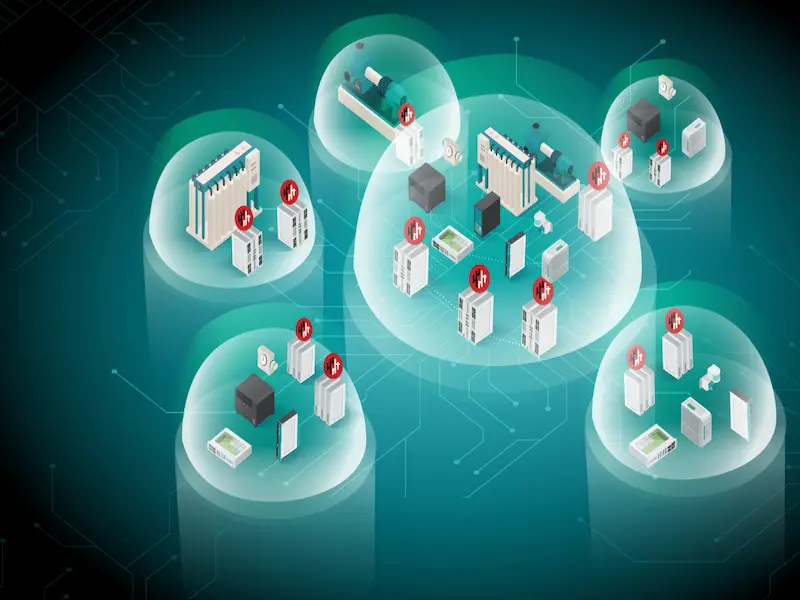- Network segmentation helps to contain breaches by isolating critical systems and sensitive data, reducing the risk of widespread attacks.
- By dividing the network into smaller segments, organisations can minimise broadcast traffic and optimise resource allocation, leading to enhanced efficiency.
- Segmentation makes it easier to meet regulatory requirements by controlling access to sensitive information and demonstrating effective security measures.
The importance of cybersecurity cannot be overstated in this digital era. As organisations increasingly rely on technology to manage sensitive data and critical operations, they become prime targets for cyber threats. One effective strategy to mitigate these risks is network segmentation.
This technique involves dividing a larger IT network into smaller, isolated segments, each with its own security policies and controls. Let’s explore the concept of network segmentation, its benefits, and best practices for implementation.
Also read: Maximising security and efficiency with network segmentation
Also read: The importance of network segmentation in cybersecurity
- What is network segmentation?
- Why is network segmentation important in cybersecurity?
- Key components of network segmentation
- Types of network segmentation
- How to implement network segmentation
- Challenges of network segmentation
- The role of network segmentation in zero trust security
- Future trends in network segmentation
- FAQs: Understanding network segmentation in cybersecurity
What is network segmentation?
Network segmentation is the practice of dividing a computer network into multiple subnetworks or segments. Each segment operates as a unique entity with its own set of access controls and policies. This compartmentalization limits access to critical systems and reduces the risk of a breach spreading throughout the entire network.
By segregating networks, organizations can create a layered defense system. For example, a company might separate its HR and finance departments’ networks to restrict access to sensitive payroll data. Network segmentation is a foundational component of a Zero Trust architecture, where no user or device is inherently trusted.
Also read: The first step in creating effective cybersecurity controls
Also read: Google and Australia team up for cybersecurity boost

Why is network segmentation important in cybersecurity?
1. Reduces Attack Surfaces
Network segmentation minimizes the pathways that cybercriminals can exploit. By isolating critical systems and sensitive data, it becomes significantly harder for attackers to move laterally within a network.
2. Enhances Compliance
Many industries, such as healthcare and finance, have strict regulations regarding data security. Network segmentation helps organizations comply with standards like HIPAA, GDPR, and PCI DSS by ensuring sensitive data is only accessible to authorized personnel.
3. Limits the Spread of Malware
In the event of a breach, segmentation acts as a containment strategy, preventing malware or ransomware from spreading across the entire network.
4. Optimizes Performance
Segmented networks often experience improved performance since traffic is confined to specific segments, reducing congestion and improving response times.

Key components of network segmentation
To implement effective network segmentation, organizations need to understand its key components:
1. Virtual Local Area Networks (VLANs)
VLANs allow administrators to partition a physical network into multiple logical segments. VLANs are a cost-effective way to enhance security without requiring additional hardware.
2. Access Control Lists (ACLs)
ACLs define the rules that regulate traffic between segments. They allow administrators to permit or deny traffic based on IP addresses, protocols, or ports.
3. Firewalls
Firewalls play a critical role in network segmentation by controlling traffic flow between segments. Modern firewalls often include intrusion detection and prevention systems (IDPS) for added security.
4. Software-Defined Networking (SDN)
SDN enables dynamic and flexible network segmentation by decoupling the control plane from the data plane. This approach simplifies management and improves scalability.

Types of network segmentation
Network segmentation can be categorized into several types based on its scope and purpose:
1. Physical Segmentation
This involves using separate hardware, such as switches and routers, to create distinct network segments. While highly secure, physical segmentation can be costly and complex to manage.
2. Logical Segmentation
Logical segmentation uses technologies like VLANs and SDN to create virtual boundaries within a network. It is more flexible and cost-effective than physical segmentation.
3. Microsegmentation
Microsegmentation is an advanced form of segmentation that operates at the application or workload level. It uses fine-grained policies to control traffic and is a key feature of Zero Trust architectures.
In an era of increasing cyber threats, network segmentation provides the resilience organizations need to stay ahead, ensuring critical assets remain protected even in the event of a breach.
Jane Smith, Chief Information Security Officer
How to implement network segmentation
1. Assess Your Network: Start by mapping your network to identify critical assets, traffic flows, and vulnerabilities. This step helps in designing an effective segmentation strategy.
2. Define Segmentation Policies: Determine which systems, applications, and users require access to specific segments. Create policies that align with your security objectives and compliance requirements.
3. Use the Right Tools: Leverage VLANs, firewalls, and SDN solutions to create and enforce segmentation. Ensure that these tools are properly configured to prevent misconfigurations.
4. Monitor and Update: Regularly monitor network traffic to ensure that segmentation policies are effective. Update configurations as needed to adapt to new threats or business requirements.

Challenges of network segmentation
While network segmentation provides substantial benefits in terms of security and performance, implementing and maintaining it can present significant challenges for organizations. These challenges often stem from the technical complexity, resource requirements, and ongoing efforts needed to ensure its effectiveness.
1. Complexity
Designing and managing segmented networks can be a highly complex task, particularly for large organizations with extensive IT infrastructures. Networks often consist of numerous devices, applications, and users, all of which must be carefully categorized and allocated to the appropriate segments. This complexity increases when dealing with legacy systems that may not easily integrate with modern segmentation technologies. Misconfigurations or gaps in segmentation can lead to vulnerabilities, potentially undermining the security benefits. Moreover, organizations must balance segmentation efforts with maintaining operational efficiency, ensuring that legitimate traffic and workflows are not disrupted.
2. Cost
Network segmentation often requires significant financial investment, especially during initial implementation. Organizations may need to purchase additional hardware, such as switches and firewalls, or adopt advanced software-defined networking (SDN) solutions to manage segmentation effectively. Training IT staff to design, implement, and maintain segmented networks is another cost factor. Small and medium-sized enterprises (SMEs) may find these expenses challenging to justify, especially if they lack dedicated cybersecurity budgets. Furthermore, hidden costs, such as downtime during implementation or troubleshooting misconfigurations, can add to the overall expense.
3. Maintenance
Effective network segmentation is not a “set it and forget it” solution. Segmentation policies must be continuously reviewed, updated, and fine-tuned to adapt to evolving threats, changes in business requirements, and technological advancements. For example, as organizations adopt new applications or onboard additional devices, these changes must be incorporated into the segmentation strategy. This ongoing maintenance requires dedicated resources and expertise, adding to the workload of IT and cybersecurity teams. Failure to keep segmentation up-to-date can result in security gaps, negating the intended benefits.
Also read: Network segmentation enhances security and performance
Also read: What are network sockets?

The role of network segmentation in zero trust security
Network segmentation is a fundamental component of Zero Trust security, an approach that emphasizes the principle of “never trust, always verify.” Zero Trust assumes that threats can originate from both outside and within the network, requiring strict verification and access controls for all users, devices, and applications. Network segmentation complements this model by dividing the network into smaller, isolated segments, each with its own access policies and security controls.
By isolating systems and restricting access to only what is necessary for specific users or processes, segmentation reduces the risk of unauthorized lateral movement within the network. For example, in a segmented environment, even if an attacker gains access to a single segment, they are unable to traverse the network to reach critical systems or sensitive data. This containment minimizes potential damage and provides more time for incident detection and response.
Network segmentation also enhances visibility and monitoring, key components of Zero Trust. By creating distinct network zones, security teams can more easily detect anomalies and enforce granular policies. When combined with microsegmentation, this approach allows for even finer control, protecting individual workloads or applications.
In a Zero Trust architecture, segmentation is not just a security measure—it’s a proactive strategy that aligns with modern cybersecurity needs, ensuring resilience against increasingly sophisticated threats.
Network segmentation is not just a security measure; it’s a strategic approach to isolating risks and mitigating the impact of cyberattacks.
John Doe, Cybersecurity Expert
Future trends in network segmentation
The future of network segmentation is set to be heavily influenced by emerging technologies such as artificial intelligence (AI), machine learning, and software-defined networking (SDN). These advancements offer the potential to automate and streamline segmentation processes, making them more adaptive and efficient in addressing evolving cybersecurity threats.
AI-driven segmentation, for example, can analyze network traffic patterns in real-time, automatically recommending or adjusting segmentation policies to optimize security and performance. This reduces the manual workload for IT teams and allows for quicker responses to network anomalies. Furthermore, AI can predict potential vulnerabilities based on past data, enabling proactive measures.
Dynamic segmentation will also become a more prominent feature, allowing networks to automatically adjust segmentation based on real-time security risks or changing business needs. This flexibility will enhance the network’s ability to respond to evolving threats or sudden changes in workload demands without manual intervention.
With the proliferation of IoT devices, network segmentation will become even more critical. IoT devices, which often lack robust security, will need to be isolated in separate segments to prevent unauthorized access and mitigate risks from vulnerable endpoints. As IoT continues to grow, effective segmentation will be vital in safeguarding the integrity of the entire network.
FAQs: Understanding network segmentation in cybersecurity
Network segmentation is the practice of dividing a computer network into smaller, isolated segments or sub-networks. This is done to improve security, performance, and traffic management. By separating different areas of the network, organizations can better control access, limit lateral movement for attackers, and reduce the risk of a widespread breach.
Network segmentation enhances cybersecurity by limiting the attack surface. If one segment is compromised, segmentation prevents attackers from moving laterally across the network to other systems or sensitive data. It also helps in containing malware, minimizing damage, and complying with security standards and regulations.
In a Zero Trust security model, no one—inside or outside the network—is trusted by default. Network segmentation plays a crucial role by isolating critical systems, enforcing strict access controls, and preventing unauthorized access to sensitive data. It aligns with the “never trust, always verify” principle of Zero Trust.
There are three primary types of network segmentation:
Physical segmentation: Involves using separate hardware devices like routers or switches.
Logical segmentation: Uses technologies such as VLANs or SDN to create virtual network segments.
Microsegmentation: Focuses on isolating individual workloads or applications to minimize risk.
Network segmentation can be complex, especially for large organizations with diverse IT environments. Challenges include the cost of implementation, managing and maintaining the segmented network, ensuring compatibility with legacy systems, and ongoing monitoring and updates to keep segmentation policies effective. Additionally, integration of new devices and technologies may require additional configuration to maintain secure segmentation.

